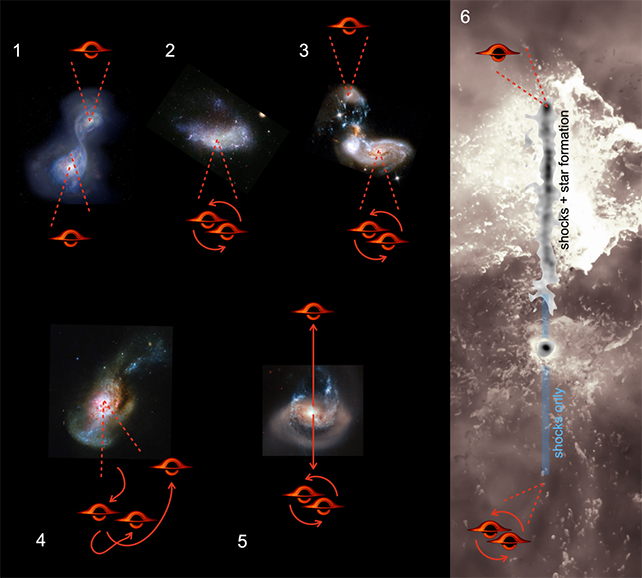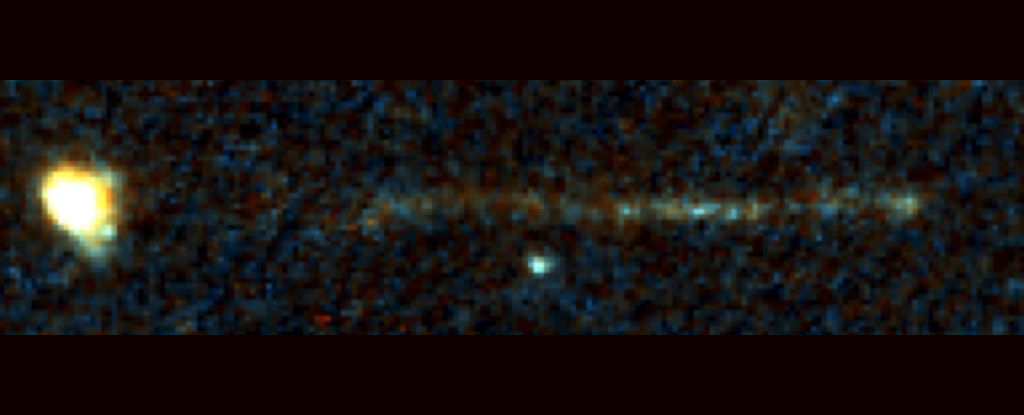Products You May Like
A trail found in the gas surrounding a distant galaxy could be the smoking gun pointing to a runaway supermassive black hole.
Based on an analysis of light that has traveled for more than 7.5 billion years to reach us, a team of astronomers has presented evidence of a colossal object ejected from its host galaxy 39 million years ago, which is now speeding across intergalactic space at 1,600 kilometers (994 miles) per second.
Although the black hole itself is invisible, its wake is not: shocks left in the tenuous intergalactic medium leave behind a trail of star formation in the compressed gas. The team’s work shows one way we could identify quiescent supermassive black holes ejected from their galaxies to zoom, invisible and untethered, through intergalactic space.
The research, led by astrophysicist Pieter van Dokkum of Yale University, has been accepted into The Astrophysical Journal Letters and is available on preprint server arXiv.
The idea that a supermassive black hole could be ejected from its galaxy isn’t actually that strange. In fact, astronomers have already identified what they think might be multiple supermassive black holes ejected from the centers of their galaxies (although none yet crossing into intergalactic space), and even one galaxy that appears to be missing its supermassive black hole altogether.
But those supermassive black holes all had one thing in common: they’re active, which means they’re surrounded by a cloud of material that’s falling into their gaping mouths of doom. This process generates insane amounts of heat and light, which makes them much easier to spot.
But not all black holes are active. And those that are quietly minding their business between snacks, just hanging out doing their thing, emit no light we can detect and are therefore essentially invisible to our technology.
However, something as weighty as a supermassive black hole – millions to billions of times the mass of the Sun – might still leave behind tracks we can spot. This is what van Dokkum and his colleagues proposed: that the trail of an ejected supermassive black hole might be detected in the gas that surrounds a galaxy, known as the circumgalactic medium.
The discovery was made in the course of other investigations. The researchers were using Hubble to study a much closer dwarf galaxy called RCP 28. It was in that image that they discovered something that might just be the trail of a runaway supermassive black hole.
The image revealed a bright streak pointing straight at the center of an irregular galaxy. Initially, the researchers thought it was a cosmic ray, but it showed up in both the filters used to process the images. So, in October 2022, they took follow-up images using the Keck Observatory, to calculate the redshift of the galaxy and streak. This gave them a size: the streak measures over 200,000 light-years in length.
Analysis showed that the galaxy and the streak have the same redshift, meaning that they are likely associated with each other, and the streak and galaxy have the same color. The team had never seen anything like it.
Looking more closely, they found that the streak was not uniform in color or brightness. It also shows signs of strong ionization, and shock regions. Some of the ionization could be explained by the presence of very young, hot, massive stars; that’s consistent with astrophysical shocks, which tend to compress gas and cause clumps of it to collapse under gravity, forming baby stars.
Streaks of light emerging from the centers of galaxies are not uncommon; these are usually astrophysical jets, powerful, narrow streams of plasma traveling at near light speeds, launched from the polar regions of active supermassive black holes. The streak the team found shows none of the hallmarks of an astrophysical jet, though.
It’s possible, the team speculated, that the passage of a jet could have left a trail of star formation in its wake; but the streak in the images doesn’t match any observed or simulated instance of jet-induced star formation on record.
In fact, the observed streak happens to be the very opposite of what astronomers would expect of a jet of gas; strongest at the farthest point from the galaxy, where there is less material, and narrower at greater distance, rather than spreading out like a jet.
The team believes that the best explanation is a runaway supermassive black hole, perturbing and compressing the circumgalactic medium as it travels through, leaving star formation behind.
You’re probably wondering what can eject a supermassive black hole from its galaxy, and the answer is: another supermassive black hole. Or two. In the researchers’ scenario, two galaxies merged once upon a time; the supermassive black holes at the cores of these galaxies came together into a binary supermassive black hole, and stayed that way for a while.
Then along came a third galaxy, and the supermassive black hole therein sank to the center of the newly merged trio of galaxies, resulting in a three-body interaction known as the Hills mechanism that flung one of the black holes away at high speeds.

Future observations across multiple wavelengths will be able to help astronomers figure out if this is indeed the case. Meanwhile, because the feature is so distinctive, other examples should be relatively easy to find, particularly with more powerful instruments, like the upcoming infrared Nancy Roman Grace Space Telescope.
“We make the case that the feature is the wake of a runaway SMBH, relying on the small number of papers that have been written on this topic in the past fifty years,” the researchers write in their paper.
“This area could benefit from further theoretical work, particularly since these papers propose a variety of formation mechanisms for the wakes. Hydrodynamical simulations that model the shocks and also take gravitational effects into account might bring these initial studies together in a self-consistent framework.”
The research has been accepted for publication in The Astrophysical Journal Letters, and is available on arXiv.
